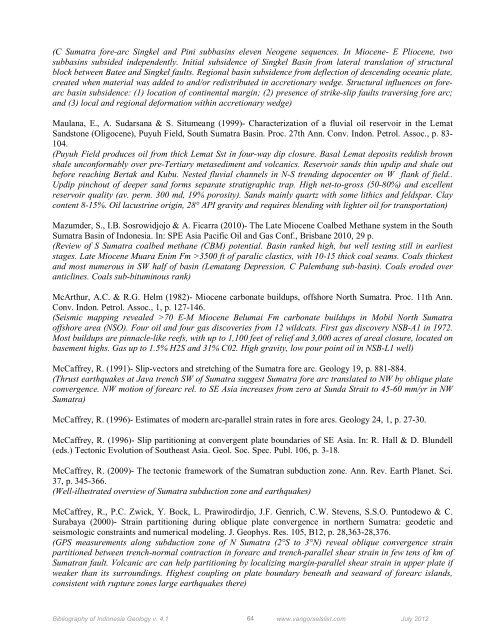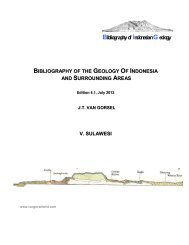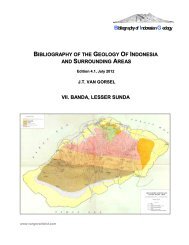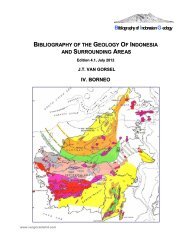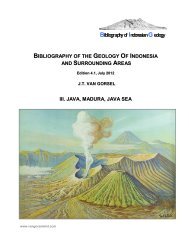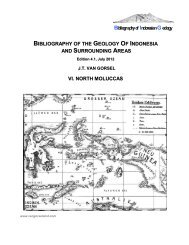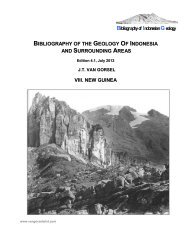Sumatra, Sunda Shelf, Natuna - Bibliography of Indonesia Geology
Sumatra, Sunda Shelf, Natuna - Bibliography of Indonesia Geology
Sumatra, Sunda Shelf, Natuna - Bibliography of Indonesia Geology
You also want an ePaper? Increase the reach of your titles
YUMPU automatically turns print PDFs into web optimized ePapers that Google loves.
(C <strong>Sumatra</strong> fore-arc Singkel and Pini subbasins eleven Neogene sequences. In Miocene- E Pliocene, two<br />
subbasins subsided independently. Initial subsidence <strong>of</strong> Singkel Basin from lateral translation <strong>of</strong> structural<br />
block between Batee and Singkel faults. Regional basin subsidence from deflection <strong>of</strong> descending oceanic plate,<br />
created when material was added to and/or redistributed in accretionary wedge. Structural influences on forearc<br />
basin subsidence: (1) location <strong>of</strong> continental margin; (2) presence <strong>of</strong> strike-slip faults traversing fore arc;<br />
and (3) local and regional deformation within accretionary wedge)<br />
Maulana, E., A. Sudarsana & S. Situmeang (1999)- Characterization <strong>of</strong> a fluvial oil reservoir in the Lemat<br />
Sandstone (Oligocene), Puyuh Field, South <strong>Sumatra</strong> Basin. Proc. 27th Ann. Conv. Indon. Petrol. Assoc., p. 83-<br />
104.<br />
(Puyuh Field produces oil from thick Lemat Sst in four-way dip closure. Basal Lemat deposits reddish brown<br />
shale unconformably over pre-Tertiary metasediment and volcanics. Reservoir sands thin updip and shale out<br />
before reaching Bertak and Kubu. Nested fluvial channels in N-S trending depocenter on W flank <strong>of</strong> field..<br />
Updip pinchout <strong>of</strong> deeper sand forms separate stratigraphic trap. High net-to-gross (50-80%) and excellent<br />
reservoir quality (av. perm. 300 md, 19% porosity). Sands mainly quartz with some lithics and feldspar. Clay<br />
content 8-15%. Oil lacustrine origin, 28° API gravity and requires blending with lighter oil for transportation)<br />
Mazumder, S., I.B. Sosrowidjojo & A. Ficarra (2010)- The Late Miocene Coalbed Methane system in the South<br />
<strong>Sumatra</strong> Basin <strong>of</strong> <strong>Indonesia</strong>. In: SPE Asia Pacific Oil and Gas Conf., Brisbane 2010, 29 p.<br />
(Review <strong>of</strong> S <strong>Sumatra</strong> coalbed methane (CBM) potential. Basin ranked high, but well testing still in earliest<br />
stages. Late Miocene Muara Enim Fm >3500 ft <strong>of</strong> paralic clastics, with 10-15 thick coal seams. Coals thickest<br />
and most numerous in SW half <strong>of</strong> basin (Lematang Depression, C Palembang sub-basin). Coals eroded over<br />
anticlines. Coals sub-bituminous rank)<br />
McArthur, A.C. & R.G. Helm (1982)- Miocene carbonate buildups, <strong>of</strong>fshore North <strong>Sumatra</strong>. Proc. 11th Ann.<br />
Conv. Indon. Petrol. Assoc., 1, p. 127-146.<br />
(Seismic mapping revealed >70 E-M Miocene Belumai Fm carbonate buildups in Mobil North <strong>Sumatra</strong><br />
<strong>of</strong>fshore area (NSO). Four oil and four gas discoveries from 12 wildcats. First gas discovery NSB-A1 in 1972.<br />
Most buildups are pinnacle-like reefs, with up to 1,100 feet <strong>of</strong> relief and 3,000 acres <strong>of</strong> areal closure, located on<br />
basement highs. Gas up to 1.5% H2S and 31% C02. High gravity, low pour point oil in NSB-L1 well)<br />
McCaffrey, R. (1991)- Slip-vectors and stretching <strong>of</strong> the <strong>Sumatra</strong> fore arc. <strong>Geology</strong> 19, p. 881-884.<br />
(Thrust earthquakes at Java trench SW <strong>of</strong> <strong>Sumatra</strong> suggest <strong>Sumatra</strong> fore arc translated to NW by oblique plate<br />
convergence. NW motion <strong>of</strong> forearc rel. to SE Asia increases from zero at <strong>Sunda</strong> Strait to 45-60 mm/yr in NW<br />
<strong>Sumatra</strong>)<br />
McCaffrey, R. (1996)- Estimates <strong>of</strong> modern arc-parallel strain rates in fore arcs. <strong>Geology</strong> 24, 1, p. 27-30.<br />
McCaffrey, R. (1996)- Slip partitioning at convergent plate boundaries <strong>of</strong> SE Asia. In: R. Hall & D. Blundell<br />
(eds.) Tectonic Evolution <strong>of</strong> Southeast Asia. Geol. Soc. Spec. Publ. 106, p. 3-18.<br />
McCaffrey, R. (2009)- The tectonic framework <strong>of</strong> the <strong>Sumatra</strong>n subduction zone. Ann. Rev. Earth Planet. Sci.<br />
37, p. 345-366.<br />
(Well-illustrated overview <strong>of</strong> <strong>Sumatra</strong> subduction zone and earthquakes)<br />
McCaffrey, R., P.C. Zwick, Y. Bock, L. Prawirodirdjo, J.F. Genrich, C.W. Stevens, S.S.O. Puntodewo & C.<br />
Surabaya (2000)- Strain partitioning during oblique plate convergence in northern <strong>Sumatra</strong>: geodetic and<br />
seismologic constraints and numerical modeling. J. Geophys. Res. 105, B12, p. 28,363-28,376.<br />
(GPS measurements along subduction zone <strong>of</strong> N <strong>Sumatra</strong> (2°S to 3°N) reveal oblique convergence strain<br />
partitioned between trench-normal contraction in forearc and trench-parallel shear strain in few tens <strong>of</strong> km <strong>of</strong><br />
<strong>Sumatra</strong>n fault. Volcanic arc can help partitioning by localizing margin-parallel shear strain in upper plate if<br />
weaker than its surroundings. Highest coupling on plate boundary beneath and seaward <strong>of</strong> forearc islands,<br />
consistent with rupture zones large earthquakes there)<br />
<strong>Bibliography</strong> <strong>of</strong> <strong>Indonesia</strong> <strong>Geology</strong> v. 4.1 64 www.vangorselslist.com July 2012


